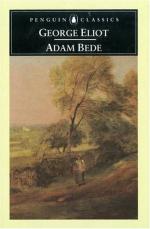|
This section contains 7,638 words (approx. 26 pages at 300 words per page) |

|
SOURCE: “Dutch Painting and the Simple Truth in Adam Bede,” in Studies in the Novel, Vol. XXIV, No. 4, Winter, 1992, pp. 366-80.
In the following essay, Gunn examines Eliot's discussion of Dutch genre painting and its relationship to realism in Adam Bede.
When George Eliot compared her fiction to the work of Dutch genre painters in chapter 17 of Adam Bede, admiring the “rare, precious quality of truthfulness” in these “Dutch paintings, which lofty-minded people despise” (1:268), she did more than simply announce her intentions as a realist writer.1 She also marked off a conventional space for “common coarse people” (1:270) in her novel, using a conspicuous visual precedent to define and imagine the rural artisans and tenant farmers she had chosen to represent. The Dutch painting analogy begins as a gloss on the Reverend Irwine's moral weakness, but it quickly opens into an apology for the presence of characters whose class...
|
This section contains 7,638 words (approx. 26 pages at 300 words per page) |

|


